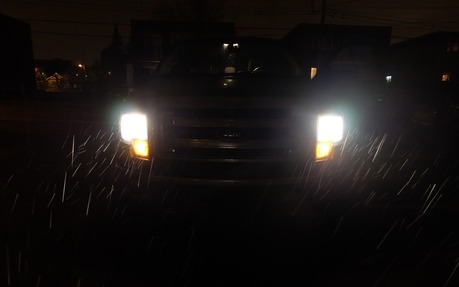Getting Ready For Winter: A Bright Idea
This article is a paid advertorial by SYLVANIA
We all realize that winter conditions should dictate some changes to our driving habits: slowing down, leaving a wider gap to vehicles ahead of us, planning our lane changes well ahead and so on.
Yet all too often, we see drivers on the road in vehicles that are ill-prepared for adventures in the snow! Getting ready for the long months of winter should also involve getting your vehicle ready. So how do we go about getting our car or truck ready to cope with the weather so it can bring us safely to our destination? A few suggestions:
First thing to remember is that the only thing connecting you to the road is your tires. Make sure you have winter tires fitted, that they are properly inflated and that there is plenty of tread left. Obviously, they should all be of matching type with similar tread depth. Remember that in Quebec, the law requires the installation of winter tires by December 15.
Next, a bumper-to-bumper inspection of your vehicle would not do any harm. This will give you a good idea of its condition, and reduce the chances of finding yourself stalled on the shoulder of the freeway during a snowstorm.
Next time your car is in for service, why not change your wiper blades? Some types of blade do a better job of clearing snow and slush from your windshield.
Another easy way of improving your view of the road and visibility is to swap your old headlight bulbs for SYLVANIA SilverStar® ULTRA high-performance units. Since it is dark earlier in winter, we spend more time driving at night. SYLVANIA SilverStar® ULTRA bulbs not only have a longer range than your original equipment halogens, but they cast a wider beam and provide 4100K illumination, which is like sunlight at noon. You will be able to see farther, you will have better lateral vision and you will be more visible to other drivers.
Once you have changed bulbs, get into the habit of driving with your headlights on (low beams, of course): they are more visible than daytime running lights, and if they are on, so are your taillights. Again, this makes you more visible to drivers ahead of you as well as those following.
You should always have a winter survival kit in your trunk; ideally, it should include a small shovel, some ice-melting salt, flares, a first-aid kit, a flashlight, batteries, hand warmers, booster cables and traction aids. Items like this can often make the difference between an inconvenience and a major incident.
Do not use cruise control in winter: You could lose control when the device depresses the accelerator just as you are crossing a patch of ice. It can also make you less aware of what is happening in front of you. This advice goes double for cars equipped with adaptive cruise control: the last thing you need is for your car to apply its own brakes without warning!
As much as possible, make sure your fuel tank is at least half-full at all times. The additional weight could help your vehicle find traction.
Before setting off each morning, make sure that the entire vehicle is free of snow and ice. That includes all the windows, headlights and taillights, mirrors and licence plate. If you have proximity sensors in your bumpers or a backup camera, take a moment to clean them. This will help avoid false signals to your on-board computer. And whatever you do, take a few extra minutes to clear snow off the roof of your vehicle: you don’t want to be the one riding around with a huge “mattress” of snow about to slide off...
Safe winter driving is not rocket science. Developing good driving habits and making sure your vehicle is properly equipped will greatly increase your chances of getting through to spring without incident.
